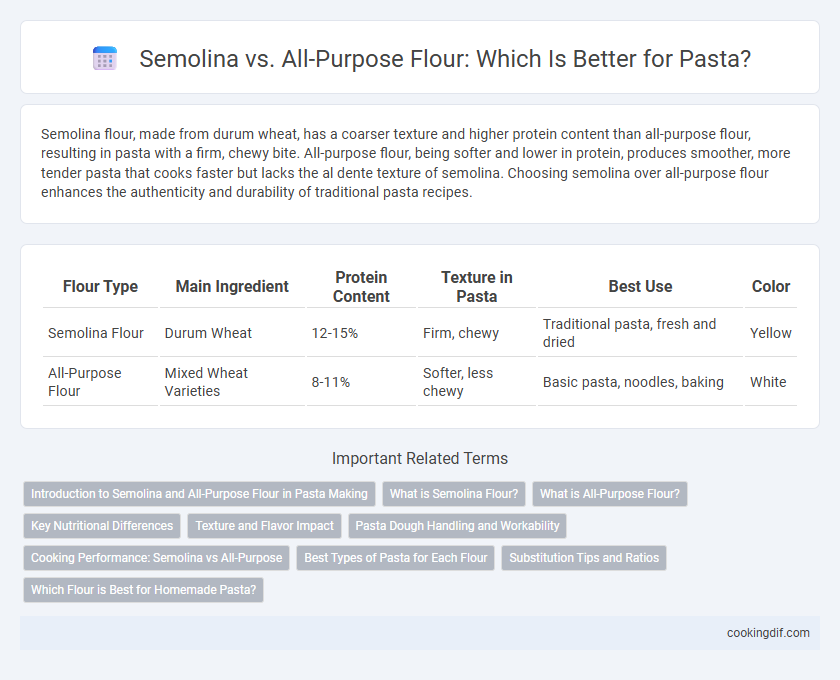Semolina flour, made from durum wheat, has a coarser texture and higher protein content than all-purpose flour, resulting in pasta with a firm, chewy bite. All-purpose flour, being softer and lower in protein, produces smoother, more tender pasta that cooks faster but lacks the al dente texture of semolina. Choosing semolina over all-purpose flour enhances the authenticity and durability of traditional pasta recipes.
Table of Comparison
| Flour Type | Main Ingredient | Protein Content | Texture in Pasta | Best Use | Color |
|---|---|---|---|---|---|
| Semolina Flour | Durum Wheat | 12-15% | Firm, chewy | Traditional pasta, fresh and dried | Yellow |
| All-Purpose Flour | Mixed Wheat Varieties | 8-11% | Softer, less chewy | Basic pasta, noodles, baking | White |
Introduction to Semolina and All-Purpose Flour in Pasta Making
Semolina flour, derived from durum wheat, offers a coarser texture and higher protein content essential for firm, al dente pasta with a slightly nutty flavor. All-purpose flour, made from a blend of hard and soft wheat, produces softer, more pliable dough better suited for delicate pasta types but lacks the structural strength of semolina. Choosing semolina enhances pasta's elasticity and bite, while all-purpose flour allows easier handling and smoother dough consistency.
What is Semolina Flour?
Semolina flour is a coarse, high-protein flour made from durum wheat, known for its golden color and slightly gritty texture. It is ideal for pasta production due to its high gluten content, which provides firm structure and a chewy bite. Compared to all-purpose flour, semolina enhances pasta's elasticity and helps it hold sauce better, making it the preferred choice for traditional Italian pasta dishes.
What is All-Purpose Flour?
All-purpose flour is a versatile, finely milled wheat flour commonly used in baking and cooking, made from a blend of hard and soft wheat varieties. It contains moderate protein content, typically around 10-12%, which affects gluten development and texture in pasta dough. Unlike semolina flour, which is coarser and made from durum wheat, all-purpose flour produces a softer, less chewy pasta, making it ideal for tender pasta shapes like fettuccine or ravioli.
Key Nutritional Differences
Semolina flour, made from durum wheat, contains higher protein and gluten content compared to all-purpose flour, which is typically made from a blend of soft and hard wheat. The increased protein in semolina provides more structure and chewiness to pasta, while its higher levels of B vitamins and iron contribute to better nutritional value. In contrast, all-purpose flour offers a finer texture but lower nutritional density, making semolina the preferred choice for traditional pasta recipes seeking enhanced texture and nutrient profile.
Texture and Flavor Impact
Semolina flour, made from durum wheat, offers a coarser texture that enhances pasta's bite with a slightly nutty flavor, making it ideal for traditional Italian pasta like gnocchi and fettuccine. All-purpose flour, being finer and softer, produces a smoother, more tender pasta with a milder taste, suitable for delicate shapes like ravioli. Choosing semolina improves firmness and flavor depth, while all-purpose flour delivers versatility and a softer mouthfeel in pasta dishes.
Pasta Dough Handling and Workability
Semolina flour, made from durum wheat, offers a coarser texture and higher protein content compared to all-purpose flour, resulting in a firmer pasta dough that maintains shape well during cooking. Its granular quality enhances dough elasticity and reduces stickiness, making it easier to roll and cut, especially for traditional pasta like spaghetti and fettuccine. In contrast, all-purpose flour produces a softer, more pliable dough suitable for delicate shapes, though it may be stickier and less resilient, requiring careful handling to prevent tearing.
Cooking Performance: Semolina vs All-Purpose
Semolina flour's coarse texture and high protein content create a firmer pasta with a slightly chewy bite, enhancing its ability to hold sauces and maintain shape through cooking. All-purpose flour produces a softer, more delicate pasta that cooks faster but is prone to sticking and losing firmness under boiling. Choosing semolina improves pasta's cooking performance by delivering a resilient, al dente texture preferred in traditional pasta recipes.
Best Types of Pasta for Each Flour
Semolina flour, made from durum wheat, is ideal for robust, al dente pasta shapes like penne, rigatoni, and fusilli due to its high protein content and coarse texture that hold sauce well. All-purpose flour, with its moderate gluten level, suits delicate pasta varieties such as fettuccine, tagliatelle, and fresh gnocchi, offering a tender bite and smoother texture. Choosing between semolina and all-purpose flour depends on the desired pasta texture and shape, optimizing cooking performance and flavor absorption.
Substitution Tips and Ratios
Semolina flour, made from durum wheat, offers a coarser texture and higher protein content than all-purpose flour, making it ideal for traditional pasta with a firm bite. When substituting all-purpose flour for semolina, use a 1:1 ratio but expect a softer dough and adjust water gradually to attain the desired consistency. For a balanced texture, combine 50% semolina with 50% all-purpose flour, which helps mimic the elasticity and flavor of classic pasta dough.
Which Flour is Best for Homemade Pasta?
Semolina flour, made from durum wheat, offers a coarse texture and high protein content that produces pasta with a firm bite and excellent elasticity, ideal for traditional homemade pasta. All-purpose flour provides a softer texture and lower gluten levels, resulting in a more tender but less resilient dough, suitable for delicate pasta shapes. For authentic pasta with optimal texture and durability, semolina flour is generally preferred over all-purpose flour.
Semolina vs all-purpose for flour Infographic

 cookingdif.com
cookingdif.com